5G

Medium Impact by 2030
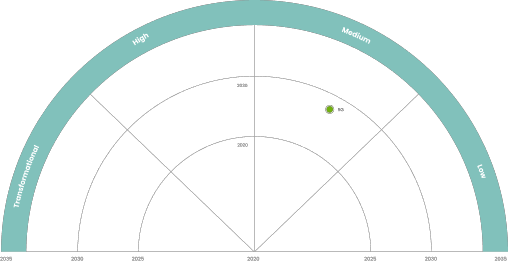
5G is the next generation wireless network technology. This will be faster and able to handle more connected devices than the existing 4G LTE network. Key benefits of 5G are Ultra low latency (~1ms vs. 100ms for 4G), Speed (Higher than 1Gbps vs. 100Mbps for 4G) and Connectivity (~1’000’000 devices / km2 vs. 100’000 for 4G). These developments are accompanied by disruptive technological choices opening up new possibilities:
- New frequencies and smart antennas :capable of managing energy in point-to-point mode between users and radio relay (beamforming).
- Virtualization technologies :distributed architecture allowing direct local processing of data for faster local actions (distributed intelligence).
- Network slicing :management of different classes and types of services according to user needs.
Highlights
Since 2022, all European countries have a commercial 5G service available at least in a part of the country. Close to 256’074 5G base stations are now active in the EU and approximately 72% of the EU’s population is covered by at least one 5G network
Challenges and opportunities for DSOs
- Distributed Energy Resources (DER)/Flexibility : 5G could facilitate DER management connection by offering solutions to activate flexibilities on LV and MV networks.
- Metering :5G could enable remote, smart or real-time metering where Broadband over Power Line is off-limits.
- Network management: : 5G connected sensors to the distribution network could enhance advanced automation and control functions like Fault Location Isolation and Service Restoration. 5G could provide new solutions to set up differential protections for MV and LV lines.
- Asset management: Sensors connected in 5G to network assets could help monitor health indexes for safety, preventive maintenance and prevent thefts. Combined with drones, 5G could facilitate component diagnosis.
- Operation: 5G could facilitate remote crew supervision support and supervision on the field.
EDSO opinions and views
- European DSOs usually rely on telecom operators and do not operate wide private telecom networks.
- 2G and 3G shutdown could lead to faster implementation by DSOs of 5G-based solutions.
- The decision of DSOs to use 5G to control critical assets will depend on guaranteed levels of reliability and resilience.
- The energy impact of the 5G rollout has to be documented as DSOs try to reduce their carbon footprint.
- Specific attention to cybersecurity issues will be necessary since many patents on 5G are held by non-European players. Furthermore, 5G cybersecurity needs some significant improvements: secured routing points, real-time cybersecurity adapted to 5G speed, and unsecured connected assets.
Hydrogen

High Impact by 2030

Today, hydrogen (H2) is almost exclusively used in industry, especially the chemical industry, metallurgy and refining. Currently, it is 96% produced from fossil fuels. Recent technological advances have improved the yields and reliability of water electrolysis processes. Hydrogen can thus be produced from decarbonized or renewable electricity. As a consequence, the significant role of the hydrogen sector in the decarbonization of the economy through its chaining with the electricity sector leads DSOs to study the impact of the development and integration of H2 technologies and systems (electrolysers, storage, fuel cells in particular) in the electricity system.
Highlights
To meet the full projected hydrogen demand in Europe by 2050 (2150 - 2750 TWh), it would take about 2900 - 3800 TWh of electricity. Despite announcements of gigawatts of electrolysers being installed over the next decade, operational electrolyser capacity is yet to reach 100 MW across Europe. While 48% of European electrolyser capacity is in Germany, no other country has more than 10 MW installed as of today. Around one third of the installed capacity is providing some form of ancillary service to the electricity system.
Challenges and opportunities for DSOs
- Connection: How big will electrolysers be? Will they be close to RES-based production or uses?
- Electricity consumption: What uses are likely to develop? What will be the impact on electricity consumption?
- Flexibility/Storage: What flexibility services could be provided and under what conditions?
- Operations: What will be the impact of H2 assets on network operation and security?
- Sector coupling: Will H2 bring momentum to the acceleration of sector coupling?
- Network planning: What will be the impact on the development of electricity networks? How will the current plans to reinforce the grid to integrate EVs (high-power chargers) be affected by the penetration of hydrogen in mobility?
- Environment: It should also be noted that the development of heavy mobility and H2 mobile generators can contribute to the decarbonization of DSOs’ activities
EDSO opinions and views
- H2 could be a solution to decarbonize heavy-duty transport, as we do not know today which will be the winning option between H2 and batteries. For light-duty vehicles, a clear choice has already been made in favour of batteries.
- There is no common view on electrolysers’ location. Most E.DSO members expect electrolysers to be installed next to electrical production sites (particularly renewable ones). However, some of them expect electrolysers to be installed next to uses to avoid H2 transport and distribution.
- Considering gas transport and distribution, reports show that H2 can be quite easily put in modern gas pipelines. This will be more complicated for old pipes but still feasible.
- There is a common view that changing home appliances would be a tremendous challenge.
MVDC and LVDC networks

Medium Impact by 2035

Although the transmission and distribution of electricity is almost exclusively carried out in alternating current (AC), certain trends call for a reconsideration of the interest of direct current (DC): (1) renewable energies (PV and wind) and batteries (in particular EV) operate natively in DC, and the acceleration of renewable energies reinforces this interest, (2) the proportion of energy consumed in DC in the home is high (50% in 2018) and growing sharply ( 80% by 2030) and (3) innovation and falling costs in power electronics are making the use of DC increasingly economical. The use of direct current could make it possible to limit conversions on the distribution network, be a source of simplification and improve the energy efficiency of the electrical system.
Highlights
DC solutions, in particular for the distribution network, are arising great interest, with numerous demonstrators around the world and, it seems, a proactive industrial policy in China.
Standardization of DC networks is of critical importance (even more for LVDC to enable development of appliances). The International Electrotechnical Commission (IEC), and Institute of Electrical and Electronics Engineers (IEEE) have all started standardization work on MV and LV DC networks.
Challenges and opportunities for DSOs
- • DC grids have several challenges to overcome : Protection systems and DC circuit breakers need further development.
- • There is a genereal lack of standardization (especially in terms of voltage levels, ohter specifications, interoperability, commissioning procedures), and DC installation costs are currently hight due to the power converters that are required.
- • Power converters are also still not as efficient as AC transforms and have a lower lifespan.
- • Connection of wind or PV plants, storage units or charging stations : a DC connection could be a relevent solution from a technical-economic point of view...
- • Microgirds : MVDC or LVDC or hybrid microgrids could develop
- • Control of power flows : a DC line could make it possible to connect two areas by controlling the flows between them.
EDSO Considerations
- • the DSOs should carry out the analyzes and implement the demonstrators necessary to identify the relevant use cases of the direct current links
- • DSOs should master the technical and economic aspects of DC networks but also the regulatory aspects
- • DSOs should mobilize to play an active role in the development of standards for DC distribution networks
- • To ensure safety of operations (power protection and control,...) experience need to be gained via some pilot projects.
Robotics

Medium Impact by 2030
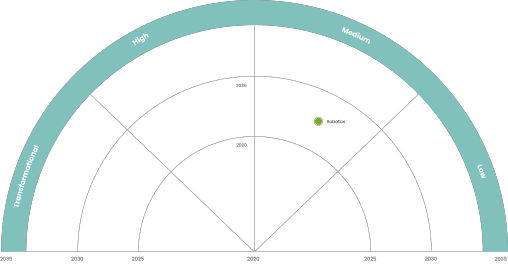
Robotics is used in multiple fields (industrial, agricultural, domestic, scientific, educational, medical, military, leisure, service, transport robotics, etc.). It is a science of technological integration at the crossroads of mechanics, electronics, computer science and networks, in particular communication. The desire to relocate production to Western countries and the ageing of the population are drivers of the revival of robotics, especially since the key technologies of robotics are experiencing spectacular advances: the rise of artificial intelligence, the sophistication of sensors, improved battery efficiency, IoT, 5G, etc.
Highlights
- The global Industrial Robots Market was valued at USD 45.1 Billion in 2021 and is all set to surpass USD 89.4 Billion by 2028. China has been the leading country in the industrial robot market for several years, with a revenue of more than 12 billion USD, accounting for 38% of the market share globally.
- Fanuc, ABB, KUKA, and Yashakawaare the four major suppliers in the market, accounting for around 56% of the global market share.
- On the proposal of the Chinese national committee, which will act as its secretariat, the IEC has created a new technical committee on robotic systems for the electrical industry, including distribution networks.
Challenges and opportunities for DSOs
- Industrial robots are able to operate in high-risk environments (live work), support heavy loads, perform arduous tasks and be available 24 hours a day, 7 days a week. Driven by an operator or autonomous and capable of adapting to their environment, they should enable DSOs to improve health, safety and productivity.
- Up to date, robots are generally used in controlled and restricted areas. DSO operation fields are various and usually not completely controlled. Under thesecircumstances adaptation and security are major challenges.
EDSO Considerations
- DSOs must identify tasks that can be robotized in their businesses in order to test available solutions, develop new ones and assess the associated gains and performance.
- The main usages for distribution networks are potentially related to maintenance and inspection.
Artificial Intelligence

High Impact by 2025
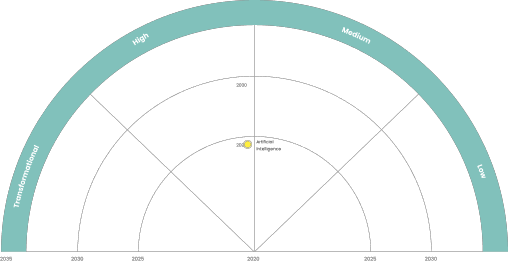
Artificial Intelligence (AI) is an interdisciplinary field that combines theory and practice. It is about assisting human activities, mainly via software and, in some cases, even replacing them. AI involves the use of information systems, data within management systems and dedicated algorithms. AI performance is based on the combination of the availability of a large amount of data, large computing capacity, and machine learning algorithms. As distribution networks are generating a growing amount of data, due to the deployment of smart meters and increased measurement and communication capabilities, DSOs have early on considered AI solutions.
Highlights
For the European Parliament, artificial intelligence represents any tool used by a machine to "reproduce human-related behaviours, such as reasoning, planning and creativity". The AI Act is a proposed European law on artificial intelligence – the first law on AI by a major regulator anywhere. The law assigns applications of AI to three risk categories. First, applications and systems that create an unacceptable risk are banned. Second, high-risk applications are subject to specific legal requirements. Lastly, applications not explicitly banned or listed as high-risk are largely left unregulated.
Challenges and opportunities for DSOs
- Production and Demand forecast: AI combined with classical solutions may improve forecast quality.
- Distributed Energy Resources (DER)/Flexibility: AI allows to handle the increasing complexity of network control due to DER variability.
- Network development studies: AI enables the realization of network development studies accounting for technical constraints, and technological and sociological hypotheses.
- Asset management: AI performances in image processing allow automatic diagnosis to enhance programmed renovation. The learning capacity of AI allows, in some cases, to perform predictive maintenance.
- Operation and employee support: AI could augment the capabilities of maintenance technicians, customer advisors and support function employees.
- Network control: AI could augment the capabilities of control rooms (fault location, DER integration). AI solutions will enable precise LV massive control.
EDSO opinions and views
- The performance of AI solutions is directly based on data availability and quality and emphasized data privacy concerns.
- Facilitating and accelerating the industrialization of AI solutions into core information systems has now become one of the major challenges of industrial AI.
- AI algorithm performance control requires special attention and dedicated monitoring tools.
- AI technologies require specific skills and companies that integrate them have to develop specific training programs.
- Development and implementation of AI solutions must be carried out with the aim of reducing carbon footprint.
- Particular attention must be paid to the ethical aspect of AI (potential concerns about justice, fairness, accountability etc. ... ).
- European legal texts under preparation must account for the specificities of DSOs.
Low Inertia Systems

Transformational by 2035
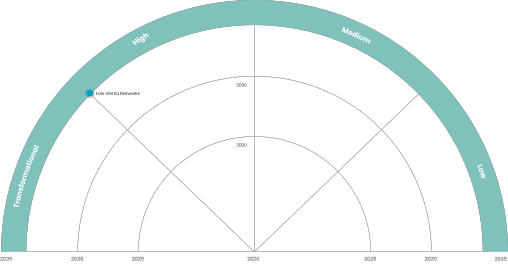
The kinetic energy of synchronous rotating machines is crucial for the stability of the power system. Current grid control and backup methods are based on this physical characteristic. In the case of solar and wind power plants, the production is injected into the grid through electronic circuits that have no inertia and therefore do not contribute to grid stability. As a consequence, the massive development of renewable energy solutions and other resources connected by power electronics leads to a decrease in the share of synchronous rotating machines in the electrical system that will cause a change in grid control and backup methods.
Highlights
Today, the inverters of renewable energies behave in a grid-following way. They synchronize themselves with the grid to produce the desired active and reactive power (depending on the primary resource). Depending on the connection level and requirements, they can “support" the grid by providing certain system services (voltage). European grid codes require some new groups to know how to provide system service frequency which requires grid-forming inverters (and other smart functions: reactive power at night, etc.).
Challenges and opportunities for DSOs
- What are the critical thresholds beyond which the safety criteria and the collapse mode of the system change?
- What are the solutions to ensure the stability of the operation of an electrical system with lower inertia?
- Which solutions are there to restore the system after a generalized incident?
EDSO Considerations
- In terms of grid stability, in a context of high penetration of renewable sources (partly connected to the distribution grid), the coordination between TSOs and DSOs becomes fundamental.
- DSOs must undertake an ambitious research and development program to find solutions to operate a low-inertia electrical system with the level of reliability and resilience required. Part of the work will have to be carried out in cooperation with the TSOs.
Bots and Highly digitized processes for operetion

Medium Impact by 2030
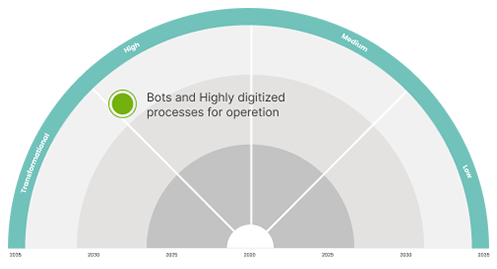
More information will be available soon...
V2G

High impact by 2030
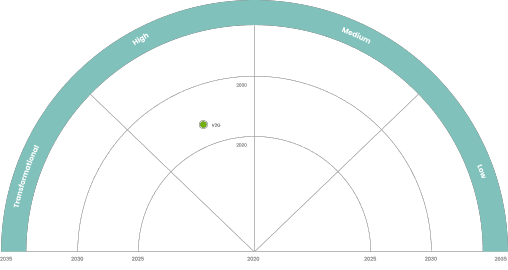
The concept of Vehicle-to-Grid (V2G) is very similar to the one of smart charging. Smart charging, also known as V1G, allows deciding how much capacity/energy to allocate to Electric Vehicle (EV) charging in real-time. V2G solutions go further and add the ability to redirect energy from a battery to the power grid to balance the network, especially when demand suddenly increases. Vehicle-to-Everything (V2X) is not very different from V2G and includes V2H (Vehicle-to-Home), V2B (Vehicle-to-Building), and V2G.
Highlights
The transportation sector is undergoing a revolution that can be seen in the growing number of electric vehicles on our roads. In addition to having a much smaller ecological footprint than combustion vehicles, electric car batteries represent an energy storage option. Globally, 140 to 240 million electric vehicles are expected to be on the road by 2030. That means there will be at least 140 million energy sources on wheels, totalling about 7 TWh of storage capacity. Today, only a few models are compatible with V2G technology. New (distributed) energy sources like V2G are challenged to compete in traditional energy markets that are not fully aligned with their capabilities. Energy regulation is complex and provides an obstacle for emerging technologies like smart car charging and V2G to make an immediate impact.
Challenges and opportunities for DSOs
- V2G’s impact on power quality and voltage control has to be analysed.
- Connection solutions have to be defined for V2G (DC or AC)
- V2G emphasize (sub-)metering (DC or AC) needs.
- The capacity of V2G, on top of smart charging, to meet local congestion and curtailment needs and its implementation must be studied.
- The capacity of V2G to provide reserve and frequency services has to be studied
- An energy aggregator can combine EV batteries and other distributed energy assets, such as solar and home batteries, into Virtual Power Plants (VPPs) that can supply and trade energy on electricity markets. DSOs have to investigate the load profiles of such VPPs.
- DSO’s technical and functional ways to call V2G have to be defined.
EDSO Considerations
- The outlook for V2X has yet to be clarified.
- In particular, the contribution of V2G in addition to smart charging must be specified.
- V2X services for other energy operators must not cause or aggravate congestion on the electricity network.
- V2X are to be incorporated in the Network Code on Requirements for Generators.
Blockchain

Medium Impact by 2030
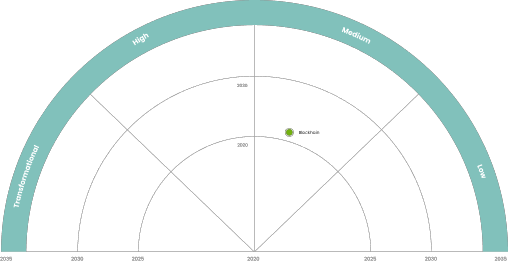
Blockchain is a transparent, secure information storage and transmission technology. It is a secure, distributed database containing the history of all exchanges made between its users since its creation: it is shared by its various users, without intermediaries, enabling everyone to check the validity of the chain. There are public blockchains, open to all, and private blockchains, whose access and use are limited to a certain number of players. In addition to cryptocurrencies, blockchain has numerous applications in the supply chain, healthcare, digital identity, asset transfer (real estate titles, shares, bonds, etc.), the Internet of Things, etc. Democratisation and decentralisation of the utility marketplace could be a key driver for the adoption of blockchain.
Highlights
In 2021, the total spending on various blockchain solutions worldwide reached $6.6 billion. According to Statista, the global spending will reach nearly $19 billion by 2024. However, the commercial added value of the technology could be much higher, reaching $176 billion by 2025 and exceeding $3.1 trillion by 2030, according to Gartner estimates. In 2017, a McKinsey study determined that blockchain could increase industry productivity by up to 9% and boost cost savings by 7%, all by simply improving progress tracking and the accuracy of cost and schedule estimates.
Challenges and opportunities for DSOs
- As a certification tool, blockchain technology could contribute to the creation of new services:
- Certification of green and local consumption, obtaining consent from customers to give new service providers access to their energy data, confidential calculation to produce inter-sectoral balances on multi-DRM, DSO/TSO perimeters, development of services in energy DataSpaces, etc.
- Monitoring transactions, including peer-to-peer (P2P) exchanges, on transactive energy markets.
- Automated certification of field work carried out by different contracting companies.
EDSO Considerations
- DSOs must follow technological and regulatory developments related to blockchain in order to make the most of these advances to improve their operational performance.
- Blockchain technology consumes a lot of energy. In the context of global warming, this point needs to be improved to make this technology compatible with the ecological transition.
- Blockchain cybersecurity raises new problems that have to be addressed.
- DSOs, which are responsible for metering data, could take advantage of blockchain to carry out this task more effectively.
Quantum computing

Transformational by 2030

Quantum computing uses the quantum properties of matter (superposition states, interference and entanglement) to perform calculations with qubits. To this end, four technologies are competing: superconduction qubits, silicon qubits, trapped ion qubits and photonic qubits. As a universal quantum computer is not yet available, industry is working with researchers to create quantum computers adapted to useful problems, and thus benefit from a real quantum advantage. Within the next 10 years, quantum computing will revolutionize a number of fields: simulation, optimization, machine learning and cryptography.
Highlights
As of 2023, GAFAM and numerous start-ups are offering Quantum Computing-as-a-Service to demystify quantum computing. The quantum advantage should be indisputable within 5 years and this explains the interest shown by governments and the funds raised in start-ups. By way of example, start-ups Pasqal (France) and IQM (Finland) raised respectively €100 million and €128 million in 2022. The risks posed by the development of quantum in the cybersecurity policy of DSOs require them to take an interest in these technologies.
Challenges and opportunities for DSOs
- Potential use cases for DSOs:
- Cryptography: cybersecurity of assets and encrypted communications for the essential service operator.
- Simulations, e.g., stochastic studies of network constraint situations.
- Optimization: local flow management.
- Machine Learning: improving the assessment of equipment condition based on image processing, improving chatbots for the relations with customers, etc.
- Real-time analysis capability of optimal network operation (minimal technical losses, Advanced FLISR Algorithms, etc.).
EDSO Considerations
- Data security is an integral part of the DSO business. DSOs need to keep a close eye on the development of quantum algorithms, which could render conventional methods of encrypting and protecting data obsolete.
LV self heating

Transformational by 2030
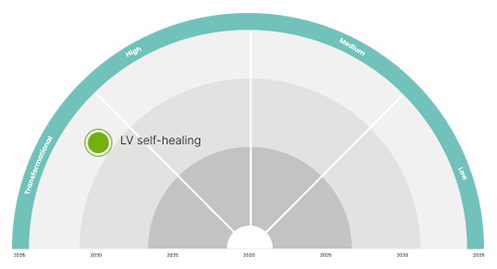
More information will be available soon...
Platforms & streaming architectures

Medium Impact by 2030

More information will be available soon...
Iot

Medium Impact by 2030

More information will be available soon...
Local energy optimization, sector integration impact on electrical system

Transformational by 2030
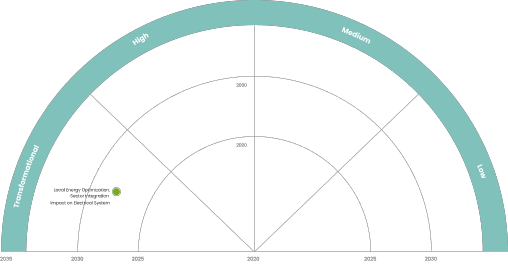
More information will be available soon...
Edge computing

Transformational by 2030
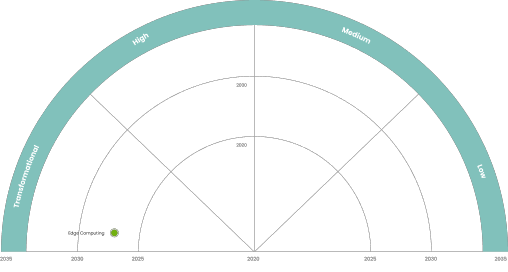
Edge computing refers to a distributed computing architecture that is characterized by decentralized processing power. In concrete terms, edge computing allows data to be processed directly by the device that produces it or by a local computer. In this case, it is no longer necessary to transmit the data to a remote data centre to analyze it. Edge computing enables data to be processed in real-time and in large quantities as close as possible to its source, with reduced bandwidth usage, lower latency and the necessary security layer for sensitive data. This technology is mainly found in the field of IoT, where it competes with cloud computing.
Highlights
Edge computing is evolving as new technologies such as artificial intelligence and machine learning bring new data analysis capabilities to the table, and emerging business models such as IoT as a service enable solution providers to deliver innovative offerings in new ways. With an average increase of 16% per year, spending on Edge Computing totalled $40 billion in 2022 in Europe and should reach $64 billion in 2025. Service providers, editors and manufacturers are sharpening their offers to meet the growing demand from companies.
Challenges and opportunities for DSOs
- Converge the intelligence present in the field (MV/LV substations, metering, IoT, etc.) to enable local processing of flexibilities integrating electric mobility and renewables.
- Ensure real-time microgrid management capability and evaluate new resilience capabilities for smart grids.
- Ensure the management and maintenance of the fleet (volume, disparity of configurations according to usage and remote updates).
- Reconcile digital sobriety and edge computing (increased energy consumption by micro-datacenters).
EDSO Considerations
- DSOs should carry out the analyses and implement the demonstrators necessary to identify relevant use cases for edge computing.
- Benefits of edge computing solutions are quite obvious for secondary substations. However, DSOs should not overlook the contribution of such solutions at the primary substations and along the network.
- DSOs should participate in ongoing discussions with the industry on governance and standards (cybersecurity, software solutions, definition of future standards) to promote the specific requirements of DSO.
- DSOs need to develop their security strategy for edge computing.
Innovative charging for electric mobility

Medium Impact by 2035
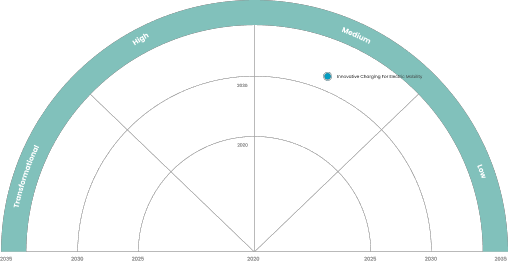
To get around the constraints of wired charging, innovative charging solutions for electric mobility are being researched and experimented. Static and dynamic wireless charging solutions at urban and high-speed operation are being tested in Europe, Asia and the USA:
- Stationary induction charging solutions are being studied, typically for charging taxis or buses while waiting at the station.
- Concerning dynamic charging, two main technology families stand out: induction charging and, more specifically for heavy-duty transport, sliding contact charging via a rail solution or via a pantograph.
Dynamic charging solutions involve significant investment costs for road infrastructure which is a significant drawback for massive road projects.
Highlights
Dynamic charging will be distributed over long distances and effectively be connected to several points in the grid. Considering inductive charging, the efficiency of the energy flow is comparable to the typical efficiency of fast charging. To limit power losses and facilitate integration with renewable energy sources, inductive solutions are generally DC-based.
Challenges and opportunities for DSOs
- Beyond the general question of network investments and power connection adapted to support the development of electric mobility, dynamic charging raises the question of defining connection solutions adapted to linear infrastructures (AC or DC delivery, etc.).
If DC solutions are adopted:
- DC grids have several challenges to overcome: protection systems and DC circuit breakers need further development.
- There is a general lack of standardization (especially in terms of voltage levels, other specifications, interoperability, and commissioning procedures), and DC installation costs are currently high due to the power converters that are required.
- Power converters are also still not as efficient as AC transformers and have a lower lifespan.
EDSO Considerations
- In collaboration with the stakeholders concerned (car and truck manufacturers, road infrastructure managers, etc.), DSOs should carry out the analyses and implement the demonstrators necessary to identify the relevant solutions and assess the impact of innovative charging options on the distribution network.
- The impact of high-power charging by induction on the grid has to be examined.
- Coupling between storage and charging solutions should be studied.
- Concerning linear charging infrastructures, the DSO perimeter has to be examined and clarified.
Superconductors

Low impact by 2035

Some metals cooled to very low temperatures (typically between -272 and -240°C) acquire the superconducting state, i.e. the ability to conduct electric current without resistance and, thus, without energy loss. Superconductivity has reached the industrial stage in some sectors for the production of intense magnetic fields such as medical imaging, particle accelerators and tokamaks. The applications of superconductivity to grid cables and current limiters have been the subject of experiments after the discovery in the mid-1980s of "high temperature" superconductivity (-196°C) which allows the use of liquid nitrogen for cryogenic purposes. Superconducting cables carry up to 5 times more energy than standard cables.
Highlights
Tests have been conducted over the past fifteen years (Long Island 2008: 600 m, 138 kV, 574 MW; Essen 2014: 1000 m, 10 kV, 40 MW). Links have recently been put into service or are planned: Shingal/Korea 2019: 1000 m, 23 k, 50 MW; Shanghai 2021: 1200 m, 35 kV, 80 MW; Chicago 2021: ~ 100 m, 12 kV, 62 MW; Paris/Gare Montparnasse link project, 2 links of 80m, 1500V DC, 5MW). Experiments with current limiters (10 kV to 138 kV, from a few MVA to a few tens of MVA) have taken place in the USA, Asia (Korea, Japan, China), Germany and the United Kingdom since the 2010s, without leading to the deployment of these solutions.
Challenges and opportunities for DSOs
- Potential use cases for DSOs: transfer of high power in a congested area (superconducting cables) or, in certain network configurations, coupling between primary substation transformers (superconducting limiters).
- Superconducting cables raise questions about operation, maintenance and safety of hybrid networks.
EDSO Considerations
- DSOs must regularly assess the maturity of superconductive technologies.
Microgrids

High impact by 2030
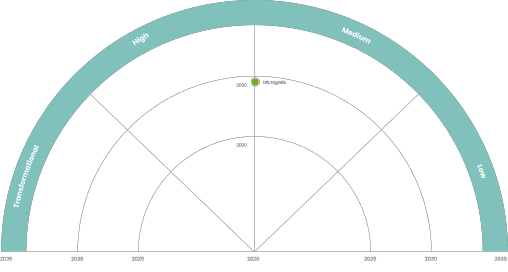
A microgrid is a group of interconnected loads and distributed energy resources with defined electrical boundaries forming a local electric power system at distribution voltage levels, that acts as a single controllable entity and is capable of operating in island mode, no matter if it is standalone or grid-connected (IEC 62898). When operating in islanded mode, microgrids can manage and optimise supply and demand (energy management system) and regulate demand locally. When operating in connected mode they may also aim to offer new services (provision of flexibilities, congestion management, reactive power management, etc.). The main objectives of microgrids are to improve resilience and decarbonize production.
Highlights
During periods when they are disconnected from the grid, microgrids operate in the same way as islands and isolated sites, which always had to produce their own electricity. Today, the strong development of renewable energy represents an opportunity to make these installations less costly and more respectful of the environment. The global microgrid market is expected to grow at a high annual rate (estimated at 10% in Europe over the period 2022-2030). Market growth is driven by the need to incorporate renewable energy and the rapid adoption of electric vehicles as well as high energy prices. Furthermore, the threat of cyber-attacks, climate hazards and geopolitical developments are stimulating the desire for energy independence.
Challenges and opportunities for DSOs
- Operating microgrids requires local energy management systems to deal with supply/demand equilibrium.
- Protection systems have to be updated to enable safe operations in islanded mode.
- Appropriate technical provisions are required to enable black start.
- Connection and disconnection of microgrids to the grid can generate local instabilities.
- The potential benefits of microgrids are technical (peak shaving, reduced energy losses, voltage regulation, etc.), environmental and economic (for participants, etc.), but the technical and contractual conditions for making these benefits effective have yet to be clarified.
EDSO Considerations
- Microgrids are still complex and expensive solutions to implement and they are not cost-effective if the grid is of good quality.
- The technical and economic competitiveness of the electricity network is therefore not called into question.
- However, in some cases, microgrids are an interesting resilience solution.
Advanced insulation materials

Medium Impact by 2030
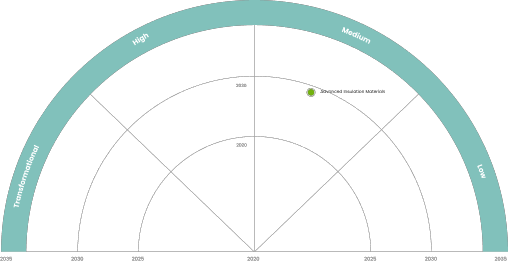
More information will be available soon...
SF6 free equipment

Medium Impact by 2030
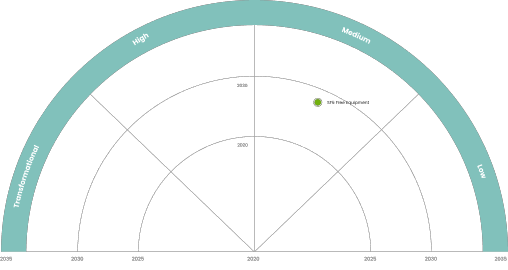
More information will be available soon...
New storage technologies

High impact by 2030
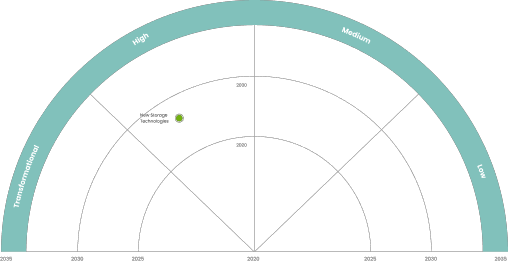
Efficient energy storage technology is needed to overcome fluctuations in renewable energy supply and decrease our reliance on fossil fuels. Storage could provide important system services that range from short-term balancing and operating reserves, ancillary services for grid stability to long-term energy storage and restoring grid operations following a blackout. Storage can help manage congestion and voltage at different timescales in the distribution network. In some cases, it could defer or even reduce the need to reinforce the network.
Highlights
Pumped-storage hydropower is the most widely used storage technology. Batteries are the most scalable type of grid-scale storage and the market has seen their strong growth in recent years. Other storage technologies include compressed air, gravity storage, superconducting magnetic energy storage, flywheels and hydrogen but these play a comparatively small role in current power systems. Up to date, apart from pumped-storage hydropower, technologies that allow for inter-seasonal or even inter-annual storage are not yet mature. The scarcity and environmental concerns related to raw materials needed to manufacture storage solutions need to be taken into account, particularly for batteries. Article 36 of the Electricity Directive restricts DSOs from owning, developing, managing or operating storage facilities, although some exceptions are possible due to efficient, reliable, safe operations etc.
Challenges and opportunities for DSOs
- In addition to the technical and economic performance of storage technologies, their geographical positioning in relation to the distribution grid will be essential for the optimization of the electricity system.
- The development of storage facilities coupled with renewable facilities can change the management of electricity flows locally.
- The development of storage facilities coupled locally with production can facilitate microgrid emergence.
- Right sizing and location of storage systems in the distribution grid is an important consideration.
- Contractual agreements between DSOs and private parties owning an operating storage are essential to align incentives.
EDSO Considerations
- DSOs must follow the technological advances of the various storage solutions in order to anticipate the possible impact of the development of these on power distribution systems and networks.
- Safety aspects of the various storage technologies, particularly batteries, are important considerations for DSOs.
EMC issues

Medium Impact by 2030

More information will be available soon...
Solid state batteries

High impact by 2030
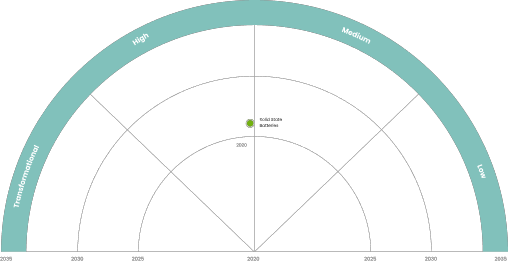
A solid-state battery uses solid electrodes and electrolytes, rather than the liquid electrolytes or polymer gels found in lithium-ion or lithium-polymer batteries. Solid-state batteries promise higher energy density than Li-ion batteries, which use a liquid electrolyte solution, as well as increased fast charging capabilities. They also entail no risk of explosion or fire, so there is no need for safety components, saving space. Worldwide efforts to make solid-state batteries a potentially safe and stable high-energy, high-throughput electrochemical storage technology are still hampered by problems of long-term performance, specific power and economic viability.
Highlights
- Solid-state batteries are expensive compared to other available alternatives such as lithium batteries. Solid-state battery prices are estimated to range from $800/kWh to $400/kWh by 2026, compared to liquid electrolyte batteries, which are currently around $156/kWh.
- EV range is limited by the energy density of the batteries and the charging rate. The energy density of solid-state batteries could be twice that of current lithium-ion batteries. Announced charging times are 10 minutes for 80% of capacity (Volkswagen in partnership with QantumSpace).
- Some solid-state battery technologies suffer from the same supply-side vulnerabilities as conventional technologies (cobalt, lithium, etc.).
- Toyota announced to be in a leading position to achieve the first functional mass-produced solid-state battery and is to be the first company to sell an electric vehicle equipped with a solid-state battery by mid-2020s.
Challenges and opportunities for DSOs
- Solid-state batteries could accelerate the development of Electric Vehicles (EVs).
- Solid-state batteries could escalate the power of charging stations on major roads.
- Thousands of batteries are installed on grids to provide autonomy to control and protect equipment. The use of solid-state batteries would allow DSOs to extend battery lifespan and improve maintenance.
- If DC solutions are adopted, several challenges must be overcome: further development of protection systems and DC circuit breakers, lack of standardization (especially in terms of voltage levels, other specifications, interoperability, and commissioning procedures), and DC installation high costs.
EDSO Considerations
- DSOs must prepare for a scenario of the emergence of solid-state batteries by analyzing the impact on investment needs, load management, etc.
- DSOs will have to perform numerous tests on solid-state batteries prior to their widespread deployment on grids.
Recycling circular economy

Medium Impact by 2030

More information will be available soon...
Automated Solution For Customer Interaction

Medium Impact by 2030

More information will be available soon...
Line carridors that support biodeversity

Low Impact by 2030
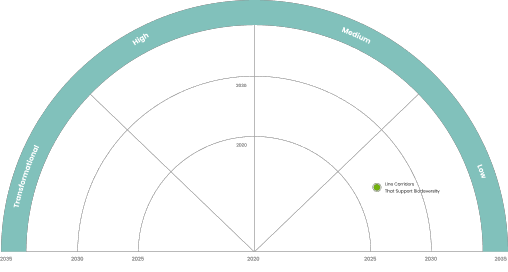
More information will be available soon...
3D Printers

Low Impact by 2030

3D printing enables the production of complex designs and shapes. Initial limits of 3D printings have been pushed back, both in the size of the objects to be produced and in the materials used (stainless steel, plastic, glass, metal, concrete, eco-materials, etc.). However, despite these advancements, the technology still faces significant challenges, including high costs, low printing speed, limited part sizes, and strength.
Highlights
The European 3D Printing Market was valued at USD 4.61 billion in 2020 and is expected to reach USD 10.12 billion by 2026. The highest demand in Europe comes from small and medium-sized businesses that are in need of high-speed, reliable and low-cost prototypes. This concerns numerous sectors, particularly automotive, healthcare, aerospace along with defence.
Challenges and opportunities for DSOs
- 3D printing allows producing small series of parts that are no longer manufactured in order to extend the life of devices, starting with rather simple devices and gradually moving to more complex ones (e.g., replacing first a hinge or a cabinet door, and later a part of an MV breaker).
- 3D printers would allow, among other things, the creation of several prototypes of equipment prior to their mass production.
- Advanced 3D printing of IoT devices and embedded sensors would entail the creation of parts and products with embedded electronics.
EDSO Considerations
- The solutions offered by 3D printers could contribute to the objectives of reducing the environmental footprint of DSOs by facilitating repair and reuse approaches.
- DSOs must follow technological developments related to 3D printers in order to make the most of these advances and improve their operational performance.
- The viability of industrial 3D printing technologies on specific use cases has yet to be validated.
Cheap sensor

Medium Impact by 2030

More information will be available soon...
Drones

High impact by 2025
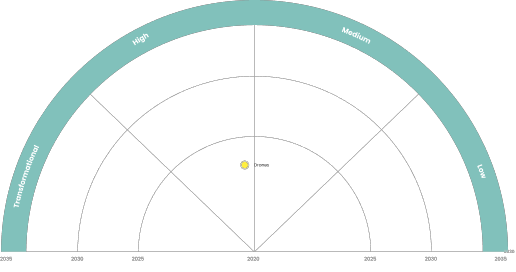
Originally developed for military applications, drones have found their way into many fields due to the improved levels of safety and efficiency they bring. These robotic Unmanned Aerial Vehicles (UAVs) operate without a pilot on board and with different levels of autonomy. Initially focused on image capture, their uses are set to expand thanks to the expected progress in drone systems (ability to fly longer distances), AI (image processing, guidance, etc.), sensors (miniaturisation of lidar, etc.), telecommunication (5G, etc.), technical action capabilities (manipulator arms, etc.). The development of the use of drones is highly dependent on regulation, which lays down strict rules that vary considerably depending on whether or not the operator is flying within sight of the UAV.
Highlights
The European Drone Strategy 2.0 sets out a vision for the further development of the European drone market. It builds on the European safety framework for operating and setting the technical requirements of drones. The new Strategy lays out how Europe can pursue large-scale commercial drone operations while offering new opportunities in the sector. The Strategy envisions the following drone services becoming part of European life by 2030: emergency services, mapping, imaging, inspection and surveillance within the applicable legal frameworks by civil drones, as well as the urgent delivery of small consignments, such as biological samples or medicines.
Challenges and opportunities for DSOs
- Lightweight drones open up the prospect of improved pruning monitoring, post-storm diagnostics, and automated infrastructure monitoring and diagnostics.
- Drones offer important benefits to utility field operations and can acquire larger volumes of data more reliably and rapidly in inaccessible or hazardous locations than on-site humans.
EDSO Considerations
- DSOs must follow technological and regulatory developments related to drones in order to make the most of these advances to improve their operational performance
- DSOs must understand the evolving requirements for data aggregation, analysis and integration with other IT systems and provide the necessary tools in line with security and governance guidelines.
- DSOs should work together to promote regulatory changes throughout the European Union that would facilitate the use of drones.
Enery system entologies data standards

Medium Impact by 2030
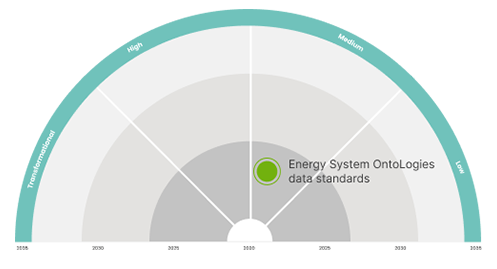
More information will be available soon...
Augmented reality

Medium Impact by 2030

More information will be available soon...
Virtual & Augmented reality

Low impact in 2025
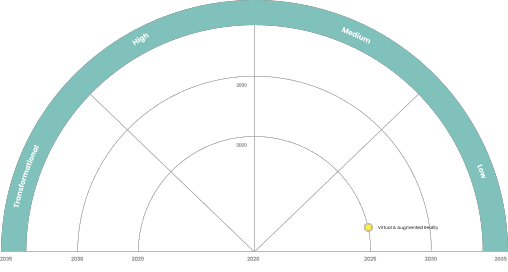
Virtual Reality (VR) refers to simulation technology, popularised by the gaming sector, which immerses a person in a digitally created artificial world, either realistic or imaginary. Other implementations such as Augmented Reality (AR) and Mixed Reality have also emerged. The current barriers, particularly in terms of reproducing the physical interaction (touch, force feedback, etc.) between the individual and the digital environment in which they are evolving, and the cost, are set to be overcome in the coming years.
Highlights
According to Statista, revenue in the Augmented and Virtual Reality market is projected to reach US$8.02bn in 2023 and US$13.61bn by 2027. Increasing use of VR in instructional training, such as for field workers, engineers, mechanics, pilots, defence personnel, and technicians in various industrial sectors, is propelling the market’s growth.
Challenges and opportunities for DSOs
- Procedural training is the first application of virtual reality, making it possible to put people into situations without the associated risks.
- VR tools also enable the remote provision of assistance by experts to field technicians during the operation of their tasks
- Discovery in immersive mode also enables businesses to showcase their activities to a non-expert audience.
- In the longer term, the technical advances expected will greatly extend the capacity for remote robot control and virtual collaborative work.
- Cooperation with AR tech companies brings challenges in the usage of a device (e.g. Hololens 2) which is not prepared for a massive rollout for electrician field workers (helmet, difficult environment electromagnetic field, complicated structure of substations).
EDSO Considerations
- DSOs must follow technological developments relating to Virtual Reality in order to make the most of these advances to improve their operational performance.
- The intensive use of virtual reality can lead to visual fatigue, dizziness, and even isolation. Therefore, its use should be balanced.
- Using AR in substations or in the field shows workers additional data (technical attributes, status, safety warnings etc.) which is very difficult regarding data quality and (near) online integration.
Cloud computing

High impact by 2025
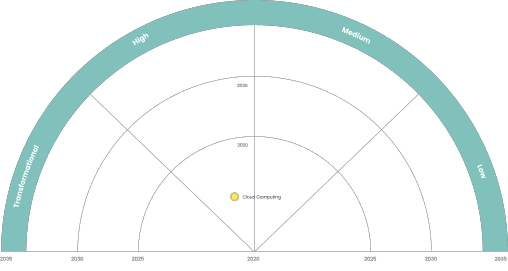
More information will be available soon...
Building Information Modeling

Medium Impact by 2030
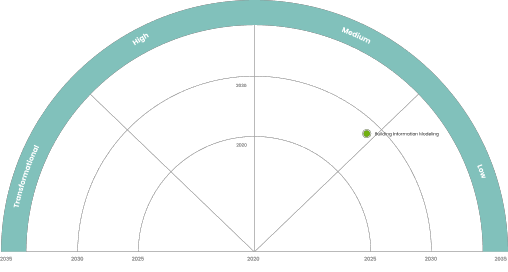
Building Information Modeling (BIM) is an approach to sharing information about a construction project throughout its life cycle, from design to demolition. The core of the approach is a structured, 3D digital model that brings together several types of information about the built asset. This digital model enables those who interact with the building to optimise their actions and maximise the overall value of the asset. This approach, which originated in the building sector, is now being extended to heavy infrastructure (bridges, ports, railways, roads) and to the energy sector (equipment, sites, networks). Thos is now known by many stakeholders as City Information Model (CIM) (not to be confused with the Common Information Model, CIM, standard developed by the electric power industry and officially adopted by IEC). BIM is a reality in the world of design and construction/renovation and is gradually being extended to the operational maintenance professions, becoming digital twins, with the acquisition of operational data.
Highlights
The importance of energy analysis in building design has grown, but it is still mostly done by simple static calculations or estimates. By utilizing BIM as a data source for energy analysis, the data input will be more efficient and the existing data more reusable to perform accurate dynamic simulation to verify the thermal performance of buildings throughout their life cycle.
Challenges and opportunities for DSOs
- BIM offers great potential for improving construction management (e.g. construction and procurement planning) and operation/maintenance management. Adopting the BIM approach presents opportunities for DSOs in terms of:
- Ability to exchange with partners in the development/engineering phases of DSOs’ projects or projects that have an impact on DSOs.
- Better detection and sharing of constraints in the upstream design phases.
- Acquisition of more reliable (digital continuum) and enhanced (3D) asset data.
- However, the development of BIM impacts the role of the different stakeholders and may limit DSOs’ autonomy in terms of network design, first in buildings and then in neighbourhoods.
EDSO Considerations
- DSOs must follow technological and regulatory developments related to BIM in order to make the most of these advances to improve their operational performance.
- DSOs must ensure that the development of BIM does not imply a detrimental loss of autonomy.
- DSOs have invested heavily in their current knowledge, processes and culture (engineering, construction, operation), which could complicate adapting to the new working methods required by BIM.
Digital Twins

High impact by 2030
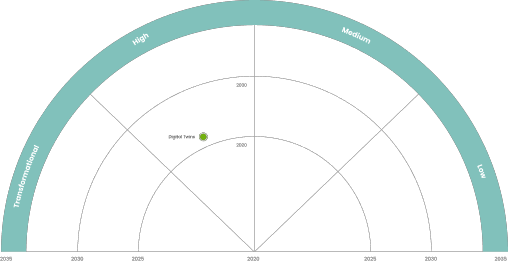
Digital twins are virtual replicas used for understanding, monitoring, diagnosing and forecasting installations, processes and, ultimately, an entire system such as the European electricity or energy system. Digital twins are emerging as future tools for improving performance through outage anticipation and increasing resilience through remote automatic control and near real-time decision-making support. Their aim is both to enable operations to be represented as closely as possible to reality, and to digitally capitalise on descriptive data about assets throughout the lifecycle of structures. Digital twisn includes four core technologies: the Internet of Things, simulations (using 3D modelling where appropriate), artificial intelligence, and cloud.
Highlights
According to Fortune Business Insights, the world digital twin market size was valued at $8.60 billion in 2022 and is projected to grow from $11.51 billion in 2023 to $137.67 billion by 2030. The DSO Entity and ENTSO-E have signed a Declaration of Intent to develop a Digital Twin of the European Electricity Grid (December 2022) in the presence of the European commissioner Kadri Simson.
Challenges and opportunities for DSOs
- Acquisition of more detailed, reliable and augmented asset data (3D technologies).
- Using digital twins, at different geographical scales, could help to determine with greater precision the real capacity for integrating renewable energies into the grid, and the rate at which they can be incorporated.
- The digital twins should enable DSOs to work better with their partners: the ability to integrate into third-party ecosystems, extended businesses for DSO activities, market platforms, smart city platforms, etc.
- Developing DSO use cases (including AR/VR) in various businesses: engineering, operations (predictive maintenance, training, safety), driving, external relations (service providers, cities, customers/suppliers), etc.
- Relying on high-performance, scalable infrastructures to exploit an ever-increasing amount and variety of internal and external data (Lidar point clouds, 3D, new sensors, etc.).
EDSO Considerations
- DSOs must follow technological and regulatory developments related to Digital Twins in order to make the most of these advances to improve their operational performance.
- DSOs must define the functional requirements of digital twins for their needs (physical asset, digital model of the asset, data flow linking the two, continuous mirroring of the asset in the digital model, feedback loop, continuous operation, etc.).
- DSOs should take an active role in the development of the Digital Twin of the European Electricity Grid promoted by the European Commission. The organisation of data sharing between DSOs, TSOs and market players, as well as the preservation of privacy, will be crucial aspects of this project.
Advanced Comms(Lore,450 Mhz etc)

Low Impact by 2025
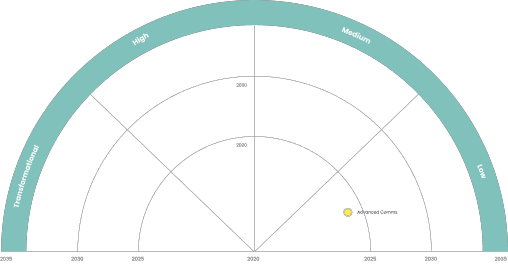
More information will be available soon...
Technology Radar

European Distribution System Operators (E.DSO) promotes and enables customer empowerment and the increase in the use of clean energy sources through electrification, the development of smart and digital grid technologies in real-life situations, new market designs and regulation. E.DSO and its members are committed to taking on the huge challenges associated with realising the Energy Union, built on the EU’s ambitious energy, climate, security of supply, jobs and growth objectives. This involves ensuring the reliability and security of Europe’s electricity supply to consumers while enabling them to take a more active part in our energy system.
The current technological landscape is very uncertain, marked by numerous and rapid developments
The current period is characterized by numerous and rapid technological developments and possible disruptions, particularly in the energy and Information Technology (IT) sectors. These transformations potentially have a significant impact on DSOs. They must therefore prepare for it, which sometimes imposes difficult choices between the subjects on which to work as a priority.
A Technology Radar has been prepared with the objective of identifying and analysing trends and stimulating innovation
The Technology Radar's ambition is to evaluate technological topics that have a potential impact on DSOs and their ecosystem (public authorities, suppliers, customers, and employees).
The objectives are:
- Early identification of new technologies, technological trends and potential disruptions
- Increased awareness of the opportunities and threats associated with emerging technological developments
- Stimulation of innovation by combining technology reports with business potential assessment.
For each trend, a fact sheet has been drawn up summarizing the key elements relating to the technology considered, the developments in progress as well as the analysis of potential impacts for the DSOs. These may consist, for example, of a change in their business model, prospects for productivity gains or opportunities to develop new services.
An aggregated view of all ongoing trends has been constructed by positioning each technology on a diagram according toestimates of industrial maturity time and magnitude of impact on DSOs. This helps to visualize key technologies as they relate to DSO activities.It should be noted that the position of each technology on this diagram is often only indicative and could be the subject of endless debate, in particular for technologies, such as artificial intelligence, which are already widely used and which however are subject to potentially disruptive new developments.
The trends analysed cover in particular energy systems, digital technologies, and the various emerging solutions serving operational performance.
The task was carried out in an effective way by a network of high-level experts
A dedicated Task Force organized within the E.DSO Technology & Knowledge Sharing Committee and including high-level experts from a large set of European DSOs was set up to produce the Technology Radar. The sourcing and analysis of technologies has been facilitated by reaching, through the network of technology scouts, the best sources of information.
The members of the Task Force were:
- Co-convenors: Pierre Mallet and Nicolas Roche (Enedis).
- Members: Ricardo Almeida Henriques (e-redes), Thomas Börmans (e.on), Aris Dandens (Sadalestikls AS), Mark den Brok (Stedin), Maurits Doorn (Stedin), Enrique Garcia (i-DE), Mariano Gaudo (UFD), Angeliki Gialketsi (Hedno), Raquel Gomez Martin (e-redes), Rene Kuczkowski (Enea PL), Jan Kula (CezDistribuce),Nuran Martin (Stedin), Ewa Mataczynska (PGE Dystrybucja), Slawomir Noske (Energa), Johannes Stürmer (Westnetz), Sergii Tankevych (dtek), Tania Vázquez Sanchez (e-redes).
Regular updating is essential
Given the rapid evolution of technologies, E.DSO plans to carry out a regular update of its Technology Radar.
Last update: 28 September 2023
Generative AI

High impact by 2030
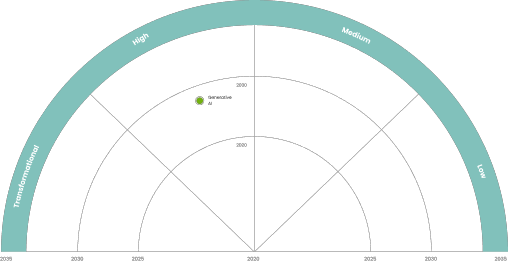
Generative AI refers to Artificial Intelligence and Machine Learning algorithms that use existing content to generate new content. Generative AI can generate text, sound, images, etc. Based on models stored in a database, it can produce its own similar model. For example, today's artificial intelligence systems can be trained to recognize a distribution network component in images, whereas Generative AI systems can be trained to generate an image of a distribution network component.
Highlights
According to Bloomberg Intelligence, the generative AI market will reach $1,300 billion by 2032. It was close to $40 billion in 2022 and should reach $67 billion in 2023. The rapid growth of the generative AI market is best illustrated by the success of chatGpT. When it was launched in 2022, chatGpT had one million users in 5 days.
EU AI act with specific requirements on Gen AI will come soon (EU AI Act: first regulation on artificial intelligence).
Challenges and opportunities for DSOs
- Large Language Models will make it possible to create texts in automatic ways (responses to customer requests, support for communications, reports, etc.).
- Generative AI will speed up code generation and software development.
- Generative AI may be used for operation and employee support, network development studies, asset management, network control, etc.
- The use of generative AI will require specialized resources and adapted validation processes (bias/accuracy monitoring, privacy and security management) before establishing confidence in processes critical to the distributor.
EDSO Considerations
- Generative AI solutions performances are directly based on data availibility and quality and emphasize data privacy concerns.
- Generative AI algorithm performance control requires special attention and dedicated monitoring tools.
- Generative AI technologies require specific skills and companies will have to develop specific training programs.
- Development and implementation of Generative AI solutions must be carried out with the aim of reducing their carbon footprint.
- Particular attention must be paid to the ethical aspect of Generative AI (potential concerns about justice, fairness, accountability etc... ).
- It will be necessary to ensure that the results of generative AI are always identified as being generated by a machine.
- It will be necessary to ensure that a "human is in the loop" when generative AI is used for decision-making and communication.
Internet of Things

Transformational by 2030
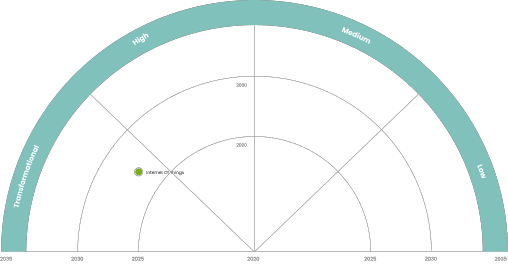
The Internet of Things (IoT) is an infrastructure of interconnected objects (mainly sensors and equipment), that contain embedded technologies to sense, communicate, process information, react and interact with each other or the external environment to create value from this interaction. IoT solutions encompass sensors, Information Technology (IT) and Operational Technology (OT) systems, communications, data storage and analysis, including AI. Increasingly, various industries are using IoT to operate more efficiently, deliver enhanced customer service, improve decision-making and increase the value of the business. With IoT, data is transferable over a network without requiring human-to-human or human-to-computer interactions.
Highlights
IoT applications deal with numerous use cases: Human health (to monitor or maintain health and wellness), Home (home voice assistants, automated vacuum cleaners, security systems, etc.), Retail environments (Devices to facilitate self-checkout, extend in-store offers, help optimize inventory, etc.), Offices (energy management, security for buildings, etc.), Standardized production environments (to gain operating efficiencies or optimize equipment use and inventory), Custom production environments (to perform predictive maintenance and health and safety efforts), Vehicles (condition-based maintenance, usage-based design, autonomous vehicles, etc.), Cities (adaptive traffic control, smart meters, environmental monitoring, etc.). IoT solutions are already available and widely used. Their applications could sharply increase in the future with the development of edge computing and 5G.
Challenges and opportunities for DSOs
- IoT could bring benefits with voltage quality analyses in different nodes and voltage loss per phase and Last Gasp.
- IoT facilitates real-time monitoring (power quality, asset characteristics, etc.)
- IoT enables powerful asset management solutions (power transformers, overhead lines, partial discharges, etc.).
- IoT could be used in the future for the implementation of decentralized flexibilities (including V1G/V2G)
EDSO Considerations
- IoT is an already available and widely used technology. Its applications could sharply increase in the future with the development of smart secondary substations and smart Low Voltage (LV) networks.
- IoT will bring the most benefits at low and medium voltage levels.
- The greatest benefits from IoT will come from:
- Substation monitoring, followed by monitoring of transformers and power quality measurements.
- Congestion management and implementation of flexibilities.
- The successful implementation of IoT needs to bridge the cultural differences between IT and OT operations.
- As IoT devices make new and different cyberattacks possible, cybersecurity is a major issue.
Direct Current Networks

Medium Impact by 2035

Although the transmission and distribution of electricity is almost exclusively carried out in Alternating Current (AC), certain trends call for a reconsideration of the interest in Direct Current (DC): (1) renewable energy (photovoltaic, PV, and wind) and batteries (in particular electric vechicels) operate natively in DC, and the acceleration of renewable energy uptake reinforces this interest, (2) the proportion of energy consumed in DC at home is high (50% in 2018) and growing sharply (80% by 2030) and (3) innovation and falling costs in power electronics are making the use of DC increasingly economical.
The use of direct current could make it possible to limit conversions on the distribution network, be a source of simplification and improve the energy efficiency of the electrical system.
Highlights
DC solutions, in particular for the distribution network, are raising great interest, with numerous demonstrators around the world and, as it appears, a proactive industrial policy in China. Standardization of DC networks is of critical importance (even more so for Low Voltage DC (LVDC) to enable the development of appliances). The International Electrotechnical Commission (IEC), and the Institute of Electrical and Electronics Engineers (IEEE) have all started standardization work on Medium Voltage (MV) and LV DC networks.
Challenges and opportunities for DSOs
- DC grids have several challenges to overcome. Firstly, protection systems and DC circuit breakers need further development.
- There is a general lack of standardization (especially in terms of voltage levels, other specifications, interoperability, and commissioning procedures), and DC installation costs are currently high due to the power converters that are required.
- Power converters are also still not as efficient as AC transformers and have a lower lifespan.
- For wind or PV plants, storage units or charging stations a DC connection could be a relevant solution from a technical-economic point of view.
- Microgrids: MVDC or LVDC or hybrid microgrids could be developed.
- Control of power flows: a DC line could allow to connect two areas by controlling the flows between them.
EDSO Considerations
- The DSOs should carry out the analyses and implement the demonstrators necessary to identify the relevant use cases of DC links.
- DSOs should master the technical and economic aspects of DC networks but also the related regulatory aspects
- DSOs should mobilize to play an active role in the development of standards for DC distribution networks
- To ensure the safety of operations (power protection and control, etc.) experience needs to be gained via pilot projects.
3D Modeling to support business processes

Medium Impact by 2030

More information will be available soon...



































